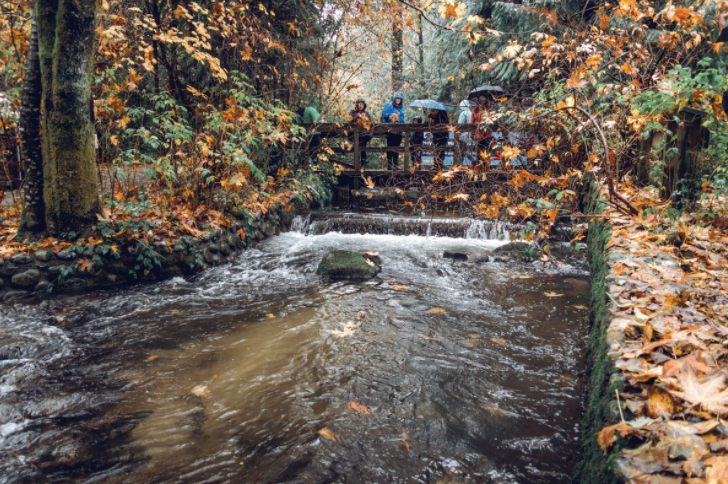When a Coquitlam homeowner dumped a can of paint down a storm drain last spring, a group of streamkeepers could only wring their hands in frustration.
That thick sludge eventually flowed downstream into an important salmon-bearing creek, and without a way to get an alert about the pollution immediately, and trace its source, members of the Hoy Scott Creek Watershed Society, could only watch in horror hours later as the fluid clogged up the the waterway.
"It’s really devastating when you see it happen, and all the fish babies that get killed," said Kim Mayes, a volunteer and director with the Hoy Scott Watershed Society, which has been conducting water quality testing of Hoy Creek for the past year.
Paint is deadly to salmon streams, such as Hoy Creek, which flows through Coquitlam's town centre and joins with Scott Creek, and eventually flows into the Coquitlam River.
In heavy concentrations paint can form a plastic layer of latex over fine sand and gravel; in a more diluted form it can suffocate fish and invertebrates further down stream.
Eventually, the source of the paint was found, thanks to someone taking a photo of the dumper.
Now, however, the City of Coquitlam can get on these problems right away, and even fine the scofflaws.
In the next few weeks, crews will be installing a Flowlink that will measure water quality variables and alert staff when problems occur.
Jonathan Helmus, the city's director of utilities, said the equipment, from a Coquitlam-based company, will be installed in the next month and used to determine water quality in real time.
"Getting live data tells a bit more of the story and if there are spills we can configure the system to get alerts, and then staff can respond right away, instead of waiting a day or two for someone to report it."
The polluter could be fined $500 and handed stop work orders, as two contractors were recently, for discharging pollutants into Stoney Creek.
Helmus said a solar-powered Flowlink has also been placed in Stoney Creek, at a cost of $35,000 in annual funding, to measure temperature, conductivity, pH, dissolved oxygen, turbidity, and water level, with the data transmitted to Burnaby and Coquitlam environmental and public works staff.
Stoney Creek, which recently had problems with construction waste and overflowing sewer water from manhole covers during during heavy rainfalls will also benefit from real time water quality measuring, Helmus said.
When there is a spike in one of the measurements, the city will respond, he said.
"I think it's one way to show that the city is being proactive," said Helmus.
Hoy Scott streamkeepers are welcoming this initiative as a way to educate the public about the importance of not dumping materials down storm drains.
Vice-president Tyler Storgaard told the Tri-City News a year of water quality testing by volunteers has determined a baseline, which can be used to measure dramatic changes with the Flowlink data, such as the impact of salting streets in the winter or cleaning solvents used by homeowners in the spring and summer.
"The best thing that will come out of Flowlink is real time data, if all of sudden there is 90 per cent dissolved oxygen, when it should be 40 per cent, it would mean there’s a pollutant, paints or solvents that would give us an alert."
Investigators would track the flow to a storm drain and then identify the culprit, he said.
"You can start searching streets for the probable cause of the occurrences," Storgaard noted.
"It's not because we want to see people penalized; we want to see education and enforcement that allows awareness in the pubic."
Storgaard would like the city to be more proactive in reporting out what happens with a spill, where it was tracked to and the consequences, so people would know what happens when they get too careless with their paint, car oil or cleaning materials.
Meanwhile, some streamkeepers would like Flowlink to be used for other purposes, such as to ensure that contractors don't dump concrete or other materials down storm drains, such as what occurred near Stoney Creek.
Kevin Ryan, who is with the Burrard Inlet Marine Enhancement Society, says water quality testing should be a requirement for construction projects.
"The next important step is to get this technology on construction sites to prevent these events entirely," Ryan stated.
For now though, these water quality testing units will at least keep an eye on water quality in at least two Coquitlam creeks, with the goal of tracking pollution in real time to prevent another toxic spring.



